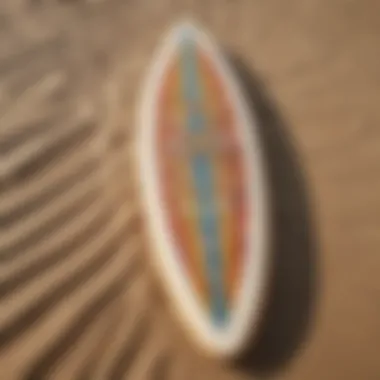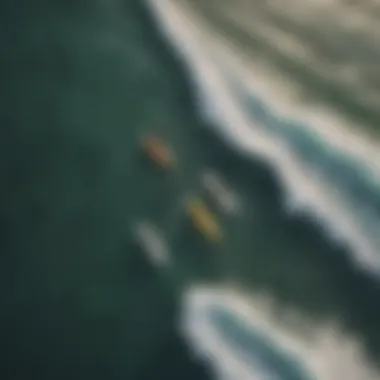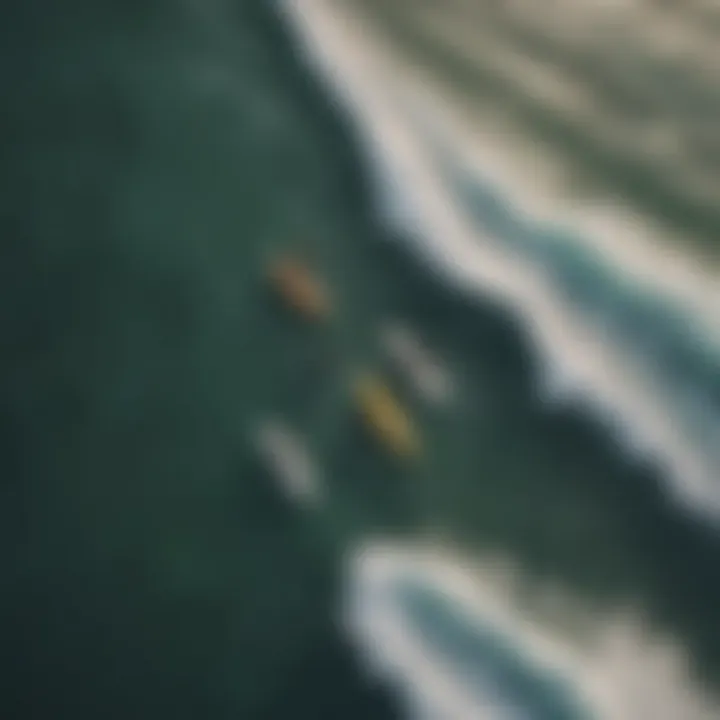The Complete Beginner's Guide to Surfing in California


Intro
California's coastline is a siren’s song for surfers. From the glittering shores of Malibu to the sun-soaked beaches of San Diego, the state offers miles of waves just waiting to be ridden. But, for those just starting their surf journey, the sea can seem a daunting expanse. With its unique surf culture and varied surf spots, California is an ideal place for newbies to learn and grow in this incredible sport.
This guide will provide a quality toolkit for beginners eager to embrace surfing. It will explore not just the fundamental techniques and safety measures, but also offer insights into how to choose the right surfboard, develop key surfing skills, and become part of an ever-evolving surf community. By understanding these aspects, new surfers can appreciate the intricacies of riding waves while honoring the culture that surrounds it.
Surfboard Reviews
As surfers quickly learn, the right board can make all the difference. Selecting a surfboard tailored to your skill level and surfing style is not something to gloss over. In this section, we’ll look at the main types of surfboards and recommend those that are best for beginners, as well as a few options for the more seasoned surfers.
Types of Surfboards: An Overview
Surfboards come in various shapes, sizes, and designs. Each type has its own set of characteristics that are useful depending on the surfer's level and the conditions of the waves. Here’s a brief rundown:
- Shortboards: Designed for performance and maneuverability. Great for experienced surfers looking for speed and agility.
- Longboards: Bigger, wider, and more stable. Perfect for beginners as they provide a larger surface for catching waves.
- Fish boards: These are shorter and have a wider tail. Ideal for small to medium waves, suitable for various skill levels.
- Funboards: An alternative between shortboards and longboards. They are versatile and good for beginners as they offer a taste of both worlds.
"Choosing the right surfboard is like finding the right partner for the dance of the ocean; compatibility is key to enjoying the ride."
Best Surfboards for Beginners and Pros
A beginner’s board should aid in stability and ease of use while a pro’s choice usually hinges on performance. Finding a quality board can be a matter of preference as much as functionality. Notable recommendations include:
- Soft-Top Longboard by Wave Bandit: Perfect for beginners who want to enjoy a stable ride without the worry of injury. The soft surface is forgiving.
- BIC Sport Mini Malibu 7'3: A fantastic hybrid for new surfers; it's durable and stable enough to help you catch waves with confidence.
- Torq Epoxy Fish Surfboard: For those ready to transition, this board provides the flexibility and speed needed for more experienced riding.
As your skills advance, considering high-performance boards like the Channel Islands Flyer can take your surfing to the next level. This board is for those who are ready to refine their skills and tackle bigger challenges.
Next, we’ll take a closer look at surfing techniques that will help beginners not just stand up but thrive on the waves.
Prelude to Surfing in California
Surfing in California is not just a pastime; it's a way of life for many. As one of the most iconic surf destinations in the world, California offers a diverse range of waves and beaches that cater to every level of skill, especially for newcomers. Getting started on this journey can feel a bit overwhelming, but understanding the fundamental elements of surfing—such as the culture, history, and techniques—can make the experience all the more enriching. This section serves as a gateway into that world, highlighting why California is a prime location for beginners.
The Allure of California Waves
Every surfer has a story, and often those stories begin with a wave. California is famed for its stunning coastline that stretches over 800 miles, presenting countless opportunities for aspiring surfers to dip their toes in the water. Here, surfers can find everything from gentle rollers perfect for learning to challenging breaks for the more adventurous at heart.
Some notable spots like Santa Cruz and Malibu boast waves that are both beautiful and rewarding, drawing surfers from all walks of life. Imagine paddling out on a warm summer day, the sun glistening on the water, ready to ride a wave that would send you gliding with joy. The thrill of catching a wave for the first time is an exhilarating experience that can spark a deep-seated passion for the sport. Beyond the thrill, there’s the unmatched beauty of California's coastline that beckons surfers to merge their love for the ocean with the vibrant beach culture.
Overview of California's Surfing History
California’s surfing roots run deep, with the sport tracing back to the early 20th century, when the Polynesians brought their surf culture to the shores. In the 1930s, surfing began to make its mark on California beaches, particularly in places like Santa Monica, where pioneer surfers shaped the scene. Over the decades, surfing has evolved tremendously. Notably, the 1960s marked a golden age for surfing, with the rise of surf movies and music gaining popularity among youth.
This rich history not only celebrates the sport itself but also emphasizes camaraderie among surfers; a bond formed over shared waves and experiences. Today, surf culture remains a mix of tradition and innovation, where respect for the ocean, the environment, and each other is paramount. By understanding this history, beginners can appreciate the sport beyond the mechanics—it’s about participating in a legacy that transcends generations.
The best way to immerse oneself in California's surf scene is to not only ride the waves but also engage with the local community, listen to their stories, and embrace the culture. Whether it's understanding the evolution of surfboards or the significance of various beaches, the depths to which California's surfing past can take a novice are endless.
"Surfing is not just a sport; it’s a culture, a passion, and a family bound by the waves."
In summary, entering the world of surfing means stepping into a history and culture that is as profound as the ocean itself. For beginners, having a grasp of what surfing in California truly represents will only enhance their journey ahead.
Understanding Surf Culture
The culture surrounding surfing in California is a tapestry woven from threads of community, passion, and respect for the ocean. For beginners, grasping the nuances of surf culture is crucial. It goes beyond just riding waves; it encompasses a lifestyle, a set of values, and a unique language. Understanding this culture makes the process more enriching and enjoyable.
Surf culture acts as a bridge, linking surfers of all levels and backgrounds. When you paddle out into the water, you’re not just riding a board; you’re stepping into a centuries-old tradition. This shared connection fosters a sense of belonging and camaraderie among surfers, enhancing the overall experience. New surfers often find themselves learning not only about techniques and equipment, but also about the unwritten rules that govern the surf community.
The Community Aspect of Surfing
One of the cornerstones of surf culture is its community aspect. Surfers often connect with one another in ways that feel organic and heartfelt. From spontaneous chats on the beach to group sessions catching waves, there’s a bond created through shared experience. Notably, California boasts a colorful mix of surfers ranging from beginners to seasoned riders, all of whom contribute to an inclusive environment.
In many surf spots, it's common to see groups forming—a collective of surfers encouraging each other, sharing tips, and celebrating victories, big or small. The friendships forged in the water often spill over into daily life, leading to a rich social fabric that’s hard to beat.
A few characteristics of the surf community include:
- Support: Newer surfers usually find others willing to help out, be it with advice or pointers on technique.
- Events: Many local beaches host competitions, clean-up days, or social gatherings that foster further community spirit.
- Shared Language: Surf culture has its own lingo. Terms like "rip current" or "localism" can make a world of difference in communication and understanding.
Respecting Local Surfers and Etiquette
Respect is crucial within the surfing community. It’s a fundamental value that guides interactions between surfers. Understanding and adhering to local surf etiquette is essential for anyone eager to ride the waves in California. Not only does it enhance the surfing experience, but it also helps avoid misunderstandings, conflicts, and potentially dangerous situations.
Some key points of surf etiquette include:
- Honoring Right of Way: The surfer closest to the peak of the wave has the right to ride it. Recognizing this rule prevents collisions and promotes smoother sessions.
- Don’t Drop In: Avoid paddling in front of someone already riding a wave. This can lead to angry encounters and disrupt the flow.
- Respect the Locals: Every surf spot has its set of regulars. A greeting or nod can go a long way in fostering goodwill. Locals appreciate when newcomers show respect for their territory.
In summary, embracing the culture surrounding surfing in California defines the experience for beginners. Understanding community dynamics, respecting etiquette, and forming connections will not only improve one's surfing journey but also cultivate a deeper appreciation for this exhilarating sport. Surfing is more than just a pastime; it's a movement that thrives on collaboration and respect as its foundation.
Equipment Essentials for New Surfers
When you’re just starting out surfing, having the right equipment is crucial. Not only does it ensure your safety, but also enhances your overall experience in the water. The right gear can make the difference between frustration and a thrilling experience.
Choosing the Right Surfboard
Choosing a surfboard can feel like stepping into a candy store—there’s so much variety! It’s important that newcomers understand the different types available and how they can shape their surfing journey.
Types of surfboards


There are a few main types of surfboards, mainly shortboards, longboards, fish, and funboards. Each comes with its own set of characteristics. For beginners, longboards are often recommended. They are typically wider and provide more stability, making it easier to catch those initial waves. Shortboards, on the other hand, are more nimble but may be trickier to balance on at first.
One unique feature of longboards is their nose, which allows for a smoother ride even when the waves are choppy. This makes them an excellent choice for those just starting out.
Size considerations
When it comes to size, bigger isn't always better, but for beginners, a larger board can be more forgiving. A good rule of thumb is to choose a board that is about the same height or taller than you. This allows for better buoyancy, which is key when paddling out to waves. The unique feature of size here is that it can affect the ease of wave catching. A larger board allows for catching smaller waves, which is perfect when you're still getting a hang of everything. It’s a common sight to see a newcomer struggling on a board too small for them, so proper sizing is crucial.
Material options
Surfboards come in a variety of materials, mainly foam, fiberglass, and epoxy. For beginners, foam boards are often favored because they are lightweight and more impact-resistant, which means they won't hurt you as much when you take a tumble.
A unique aspect of foam boards is that they float better, aiding in the learning process by keeping beginners above water while they practice paddling and balancing. While fiberglass boards offer a sleeker aesthetic and performance benefits, they aren't as forgiving in terms of falls.
Wetsuits and Other Gear
When the water is a bit chilly, wetsuits become an essential part of your surfing kit. They keep you warm and help extend your surfing sessions.
Wetsuit thickness
The thickness of a wetsuit can vary based on water temperature. Generally, thicker suits are great for colder waters. A 4/3mm wetsuit is popular for Northern California in the winter. They offer decent insulation, allowing you to enjoy the sport without turning into an ice cube.
The unique feature of these suits is insulation, which helps regulate body temperature while also providing some buoyancy. On the flip side, they might feel restrictive at first, but you often get used to it after a few session in the water.
Accessories for comfort
Accessories like booties or gloves might not seem critical, but they can make a positive difference. Booties provide grip on the board and protect your feet from sharp rocks or jellyfish. When you’re out there battling the waves, the last thing you want is an uncomfortable foot.
The unique feature of wearing booties is added traction. They help avoid slipping off your board, especially when trying to stand up.
Surf leashes and wax
Surf leashes are essential for safety. They keep your board close by even when you wipe out. That said, a leash isn’t just a convenience; it can also prevent your board from becoming a hazard to other surfers in the water.
One unique aspect of leashes is that they come in different lengths, so finding one that matches your board size is key. Wax, too, plays an understated but vital role. Applying wax gives surfers the grip they need to stay connected to their boards, reducing the chances of slipping off.
In summary, having the right gear is non-negotiable when you're starting your surfing journey. From surfboards to wetsuits, these pieces of equipment not only enhance your performance but serve as crucial parts of your overall safety and comfort in the water.
Basic Surfing Techniques
Understanding basic surfing techniques is vital for beginners who are eager to embrace the surf lifestyle. These techniques are the building blocks of your ability to ride the waves effectively and, most importantly, safely. Mastering these skills not only enhances your confidence in the water but also increases your enjoyment of the sport. Proper techniques ensure that surfers can handle different conditions, perform maneuvers, and respect the ocean's power.
Learning the fundamentals of paddling, the pop-up, and riding waves prepares new surfers for the excitement of catching their first wave. For beginners, getting these skills right is often the difference between a smooth introduction to surfing and a frustrating experience.
Paddling Basics
Paddling is the first and one of the most essential skills for any aspiring surfer. Without effective paddling, catching waves becomes a daunting task. Proper paddling technique involves using a smooth and fluid motion that engages your core and arms.
To paddle effectively:
- Position: Lying on your board with your center of gravity balanced is crucial. This minimizes drag and allows for better movement.
- Stroke Technique: Your hands should enter the water in front of your shoulders and push back in a straight line, pulling through the water efficiently. This technique provides faster and more controlled movements, allowing you to catch waves earlier.
- Breath Control: Keeping your head low while paddling helps maintain balance. It can also help in conserving energy for when you pop up or hit the waves.
Getting comfortable with paddling will also help you maneuver around other surfers and obstacles in the water, keeping you safe and enhancing your overall experience.
Pop-Up Technique
The pop-up is the moment that separates surfers from the water. It is the transition from lying flat on your board to standing up. Although it sounds simple, timing and technique are critical.
A good pop-up involves several steps:
- Preparation: As the wave approaches, choose your moment wisely. Look ahead to see where the wave is breaking.
- Push Up: Use your arms to push your chest off the board, much like a push-up. This motion moves your weight forward.
- Swift Motion: Bring one foot forward to the board while quickly bringing your back foot up. Keep your body low for better balance.
- Stance: Spread your feet shoulder-width apart and bend your knees slightly to lower your center of gravity.
This technique may take some practice, but once mastered, it allows for fluid movement and control on the waves, setting the stage for a more enjoyable surfing experience.
Riding the Wave
Riding the wave is the ultimate thrill, but it requires an understanding of wave dynamics and proper maneuvering techniques. Successful wave riding involves more than just standing up—it's about reading the waves, positioning yourself correctly, and knowing how to turn.
Understanding Wave Dynamics
Understanding wave dynamics is to know how and when waves break and the best approach for catching them. Key aspects include:
- Wave Size and Shape: Knowing the difference between a breaking wave and a swell can help you choose which waves to ride.
- Timing and Positioning: Being in the right spot at the right time means positioning yourself where the wave will break, allowing you to catch it just as it reaches its peak.
A key characteristic of wave dynamics is the idea of priority. Surfers need to respect each other's turns, which can often dictate whether one can catch the wave successfully. Recognizing these dynamics is beneficial for every surfer and fosters a respectful surfing community.
Turning and Maneuvering
Turning and maneuvering are where you can express your style as a surfer. Understanding how to shift your weight, carve turns, and navigate through the lineup effectively demonstrates control.
- Weight Distribution: Shift your weight gradually to your toes and heels, allowing for smoother turns; leaning too far can lead to losing balance.
- Carving Turns: This technique involves using your board’s edge to create smooth arcs. It’s powerful because it gives you momentum and allows you to generate speed.
Mastering these turning techniques allows for better wave rides and agility that ultimately opens up more opportunities for new maneuvers as you advance your skills. By grasping these basic techniques, beginners are better poised to enjoy the beauty and thrill of California's surf waves.
Safety Considerations
When surfing, safety is paramount. Understanding the various aspects that contribute to a safe experience in the water can significantly enhance both enjoyment and confidence for those who are just starting out. Recognizing hazardous conditions, being prepared to deal with marine wildlife, and having basic first aid knowledge are crucial elements to keep in mind. Emphasizing safety not only protects the individual but also contributes to a healthier surfing community overall.
Recognizing Hazardous Conditions
Hazardous conditions can turn an exciting surf session into a risky endeavor. A beginner needs to learn how to identify situations that could lead to accidents. Key factors to consider include:
- Wave size: Large waves may look thrilling, but they can be dangerous for inexperienced surfers. It's essential to start with manageable waves to build confidence and skill.
- Rip currents: These fast-moving channels of water can sweep even seasoned surfers away. Learning how to spot them and understanding how to escape if caught in one is vital.
- Weather changes: Storms or sudden winds can create treacherous conditions. Always check the forecast before hitting the waves.
"Surfing is about riding the waves, but it’s also about being aware of nature's power. Know the conditions before you paddle out."


Staying Safe in the Water
Safety in the water encompasses several important considerations, all aimed at ensuring a fun and secure experience.
Sun protection
Applying sun protection is absolutely crucial for surfers spending hours on the beach or in the ocean. Too much sun exposure can lead to painful sunburn or even skin problems down the line. Here are some important aspects of sun protection:
- Water-resistant sunscreen: This is a popular choice as it allows surfers to stay protected longer while enjoying their session without the need for constant reapplication.
- Wide-brimmed hat and rash guard: They provide additional protection against UV rays and help keep the skin covered.
- Key characteristic: Water-resistant sunscreens often have a higher SPF, which can translate to better protection. It's essential to select a sunscreen that blends with your skin type and offers broad-spectrum coverage.
Dealing with marine wildlife
Being in the ocean means encountering marine life, and knowing how to handle these interactions can enhance overall safety. Here are some important points to keep in mind:
- Awareness: Understanding the types of marine wildlife in the area can help surfers avoid confrontations. If you see jellyfish, sharks, or other potentially aggressive species ahead, consider altering your route.
- Key characteristic: Many marine animals tend to be curious rather than aggressive. However, maintaining a respectful distance and not provoking them can prevent unnecessary incidents.
First aid basics
Having basic first aid knowledge can make all the difference in case of an emergency. Here’s what surfers should keep in mind:
- Minor injuries: Scrapes or bruises can happen, so knowing how to clean and treat them is important. Having a small first aid kit can be useful.
- Understanding CPR and rescue procedures: This is vital for anyone surfing in groups. Knowing how to perform basic CPR could potentially save a life in case of drowning or other emergencies.
- Key characteristic: First aid training often includes not just injury treatment, but also assessing the seriousness of injuries and contacting emergency services when necessary.
Staying safe while surfing is not just about avoiding physical harm; it enhances the overall experience. As a beginner, building an awareness of hazardous conditions, preparing for wildlife encounters, and equipping oneself with first aid knowledge can lead to more enjoyable surf sessions and a deeper appreciation for this exhilarating sport.
Exploring California's Best Surf Spots
When it comes to surfing, California is a treasure trove of spots that cater to every skill level, especially for newcomers. Finding the right local beach isn’t just a matter of dodging bad waves; it plays a big part in shaping your early experiences on the board. This section zeros in on some of the best beginner-friendly surf locations across the Golden State, pinpointing what sets each apart, as well as aspects to consider while paddling out.
Top Locations for Beginners
Malibu
Malibu shines as a quintessential spot for surfers stepping into the waves for the first time. Its iconic beaches—most notably Surfrider Beach—are famed for their gentle, rolling breaks, ideal for learning. The waves here have a way of inviting beginners without overwhelming them.
- Key Characteristic: The mellow left-hand point break offers predictability.
- Benefits: Its scenery and vibrant surf culture create a motivating backdrop for learning, plus the ample surf schools around make it easy to get guidance.
- Disadvantage: On a busy weekend, it can feel like a mad house due to its popularity; sometimes it might be challenging to catch a clean wave amid the crowd.
Santa Monica
Santa Monica offers another dynamic choice with a friendly vibe for budding surfers. Its sandy beaches provide a spacious environment where beginners can spread out, practice paddling, and wait for waves.
- Key Characteristic: The beach breaks allow for various wave types, accommodating different skill levels.
- Benefits: The bustling boardwalk nearby allows for post-surf socializing or a snack run to recharge while watching the waves from the sand.
- Disadvantage: Similar to Malibu, the influx of beachgoers can make it tricky to navigate, especially when you're still mastering control on the board.
Pismo Beach
Pismo Beach brings a different feel, known for its long stretches of sand and generally less crowded atmosphere. This beach presents a more relaxed approach to learning, often resulting in fewer distractions.
- Key Characteristic: The waves are consistent and can vary in size, ideal for adapting your skills gradually.
- Benefits: It boasts a more open layout compared to its city counterparts, which can be comforting for those just starting out. Plus, the coastal town vibe adds a nice charm to the surf experience.
- Disadvantage: Some days, especially during summer, can bring strong currents which might require a watchful eye for safety.
Seasonal Considerations and Conditions
Understanding the seasons is crucial when exploring Californian surf spots. The swell fluctuates throughout the year, and knowing when to hit the surf is half the battle for beginners.
- Winter: Typically brings bigger swells, making it more suitable for advanced surfers, though some southern spots might still be manageable for newbies.
- Spring and Fall: You might find ideal conditions with moderate swells, fresh winds, and fewer crowds, offering a perfect window for practice.
- Summer: Known for smaller, more manageable waves, this season is generally the best time for beginners to hit the water.
Joining a Surf School
The journey into the waves can be thrilling yet daunting for those new to surfing. An essential step for beginners is considering joining a surf school. These schools provide more than just lessons; they create a supportive environment for learning the ins and outs of surfing. It’s not merely about standing on a board; it’s about understanding the ocean, mastering techniques, and becoming a part of the surf community. A surf school can lay the groundwork for successful and enjoyable experiences in the water.
Benefits of Professional Instruction
Attending a surf school opens doors to professional instruction. These surf schools employ experienced instructors who are often passionate surfers themselves. They've been in the trenches, facing the challenges that come with learning to surf. With their expertise, students benefit from tailored lessons that focus on individual strengths and weaknesses. This professional guidance enhances the learning experience, allowing beginners to progress at a comfortable and steady pace.
Some of the benefits of professional instruction include:
- Safety Training: Learning how to safely navigate the water is critical. Professionals teach newcomers about rip currents, waves, tides, and other hazards.
- Structured Learning Environment: Surf schools offer structured lessons that are progressive. Each session builds on the last, ensuring a solid foundation.
- Feedback and Support: Immediate feedback is invaluable when learning something new. Instructors can provide tips and encourage improvement, preventing the frustrations of self-teaching.
What to Look for in a Surf School
Choosing an appropriate surf school involves careful consideration of various factors. To make an informed decision, look for the following key components:
Instructor qualifications
Instructor qualifications are pivotal. When selecting a surf school, it's crucial to check the credentials of the instructors. Look for certifications from recognized organizations, such as the International Surfing Association. Well-trained instructors typically have a strong background in water safety alongside surfing techniques.
A notable characteristic of well-qualified instructors is their ability to teach diverse skill levels, from absolute novices to those looking to refine their skills. Having a qualified instructor ensures that new surfers are learning the proper techniques from the very beginning, setting them on a path towards improvement. However, not every instructor is the same; some may excel at teaching techniques but lack the interpersonal skills needed to connect with students. Personal rapport can greatly enhance the learning experience.
Class sizes
Class sizes can greatly impact the quality of instruction. Smaller class sizes allow for more individualized attention, which can be beneficial for beginners who may feel overwhelmed in large groups. With fewer students, instructors can focus on each learner's unique needs, ensuring that everyone receives adequate guidance and support.
A typical surf school often has a student-to-instructor ratio of no more than five to one. This setup strikes a balance between group dynamics and personalized feedback. However, larger classes can foster camaraderie among participants as they learn together, which might aid some students. Thus, striking a balance is key when considering class size.
Equipment provided
Surf schools usually provide essential equipment. Quality boards and wetsuits specifically designed for beginners can make a significant difference in comfort and performance. Most reputable surf schools invest in well-maintained gear, ensuring that students have the best chance of success.


An enticing aspect of equipment provision is that students won't always need to invest in their own boards and wetsuits right from the start. This feature is especially beneficial for those who are still figuring out if surfing is right for them. Conversely, some schools may offer limited choices in equipment, so it’s advantageous to ask ahead of time about the available gear. This can help avoid unexpected surprises on the day of the lesson.
"Choosing the right surf school is just as important as learning to surf itself; the right guidance can turn a hesitant beginner into a confident, capable surfer."
By taking these considerations to heart, aspiring surfers can set themselves up for greater success and enjoyment in their water-based adventures. The right surf school paves the way for a fulfilling surfing journey, easing the transition from land to sea.
Building Surfing Skills Over Time
Surfing, a dynamic and engaging sport, is more than just riding waves; it’s about developing skills that can only be honed over time. When you first paddle out, it might feel like trying to learn a foreign language – it takes time to become fluent.
Setting Realistic Expectations
Every surfer’s journey is unique. Setting realistic expectations is critical for mental fortitude as you progress. Expect that your initial attempts may lead to wipeouts and struggle with balance. An important thing to grasp here is that improvement doesn’t happen overnight. It’s akin to nurturing a garden; it requires patience, care, and time.
Consider the following when shaping your expectations:
- Understand your current skill level: Know where you're starting from. Whether it’s your very first day on a surfboard or if you have some wave experience, self-awareness helps you chart the right course.
- Reflect on progress, not perfection: Focus on small victories, like standing up for a few seconds or catching a wave without falling. Keep track of these milestones to keep your motivation up.
- Acknowledge the learning curve: Each wave can be unpredictable. Sometimes you ride smoothly, while other times it feels like you’re battling a monster. Accepting these realities will bolster your confidence.
Importance of Consistent Practice
Consistency is the secret sauce of any skill development, and surfing is no different. Like playing a musical instrument, you get better the more you practice. If you only hit the waves occasionally, don’t expect to develop muscle memory or refine your techniques.
Here’s why practicing consistently pays off:
- Building Muscle Memory: Just as athletes train their bodies for specific movements, frequent surfing helps your muscles learn the motions required to balance on a board and respond to wave dynamics.
- Increasing Water Awareness: Regular practice helps you become one with the ocean, understanding its rhythm better, reading sets, and predicting the best waves to catch.
- Improving Fitness Levels: Surfing is a workout that challenges multiple muscle groups. Engaging in the sport more frequently enhances your endurance, power, and flexibility.
Consistency in practice leads to an ongoing evolution in skill, much like a sculptor chisels away at a block of marble until they reveal a masterpiece.
Embracing the Surf Lifestyle
Surfing isn't just a sport; it's a lifestyle, a culture that seeps into the very fabric of those who engage with it. When one embraces the surf lifestyle, it's about more than catching the perfect wave. It becomes a journey that intertwines with nature, community, and self-discovery. In California, this is particularly significant because of the rich and vibrant surf culture that thrives along its coastline.
Adopting the surf lifestyle means developing a unique connection with the ocean. Every surfer learns to read the waves, to understand the tides, and how weather affects surf conditions. This relationship fosters a deep respect for nature, urging surfers to become more environmentally conscious. Surfing communities often rally together for beach clean-ups or campaigns to protect marine ecosystems.
Another vital aspect of this lifestyle is the sense of belonging it creates. Local surf spots are hubs of camaraderie; you’ll find friendships forged not just through the shared thrill of riding waves but also in the frequent gatherings, competitions, and rituals of the surf culture. Being part of a surf community provides support and encouragement, making strides toward personal progress in the water feel meaningful and shared with others.
Connecting with Local Communities
Engaging with local surf communities enriches the experience for beginning surfers. It offers a way to learn from seasoned surfers who have honed their skills over the years. Inviting novice surfers to participate in local events and social gatherings helps build connections that are supportive and nurturing.
Local surfers often encourage newcomers by sharing tips and techniques, which is especially beneficial in a sport where local knowledge can significantly enhance one’s experience. They can provide insights into the best surf spots suitable for beginners, as well as explain specific conditions to be aware of.
Surf Travel Considerations
Traveling to explore new surf destinations opens the door to fresh experiences. Each location presents its own unique surf culture, wave types, and environmental conditions. When you step off the beaten path, you find new challenges, encounter diverse surf communities, and witness different ways of respecting and engaging with the ocean.
Exploring New Surf Destinations
Exploring new surf destinations is like discovering a treasure chest filled with waves waiting to be ridden. For many surfers, the thrill of hitting an unfamiliar beach ignites excitement and curiosity. Whether it's the pristine coastline of Tofino in Canada or the world-renowned breaks of Hawaii, each spot offers something special.
- Key Characteristic: The variety of conditions allows surfers to adapt and refine their skills.
- Unique Features: Discovering local customs and surf spots adds depth to the overall experience.
- Advantages: Expanding your surf knowledge and technique, plus the chance to meet surfers from around the globe enhances perspectives on the sport.
- Disadvantages: On the flip side, unfamiliar waters may present hidden dangers, like strong currents or hazardous marine life.
Cultural Awareness in Surf Travel
Being culturally aware in surf travel is crucial for a positive experience. It’s important to recognize and respect the local customs and practices of the surfing communities you visit. Engaging genuinely with locals not only builds rapport but also deepens your understanding of the sport beyond just wave riding.
- Key Characteristic: Different cultures have unique traditions and rituals associated with surfing that can enrich your experience.
- Unique Features: Appreciating local surf culture often leads to a more fulfilling and respectful experience while traveling.
- Advantages: Enhances mutual respect and fosters friendships, turning an individual activity into a shared celebration of the sport.
- Disadvantages: However, ignorance of local customs can lead to misunderstandings and negative interactions that can mar the experience.
"To surf is to connect with the ocean and with those who share the passion of riding waves. It’s not merely a sport; it’s a way of life that stretches beyond the sea."
Epilogue and Next Steps
Wrapping up, it’s clear that surfing is more than just a pastime in California; it’s a way of life that embodies a unique combination of thrill and community spirit. For beginners, understanding the essence of this sport is crucial. This guide has taken you through various facets—from the allure of the waves to the necessary equipment, techniques, safety measures, and the culture surrounding surfing. All these elements combine to create a robust framework for newcomers eager to dive in.
A key point to consider is the journey doesn’t end when you ride your first wave. Instead, it marks the beginning of a lifelong adventure. The beauty of surfing lies not only in mastering the skills but also in the connections and experiences gained along the way. As you progress, staying curious and committed to improvement will yield invaluable rewards.
Encouragement to Stay Committed
To truly embrace surfing, maintaining a commitment to practice and learning is paramount. Like any sport, the initial stages might feel a bit daunting—every wave may not lead to glory, and getting tossed around by the water can be disheartening. However, dedication distinguishes a casual participant from someone who becomes a part of surf culture.
Regular practice sharpens your skills, boosts your confidence, and ultimately enhances your enjoyment on the water. Remember, every surfer has their story filled with wipeouts and triumphs. Embrace the journey and cherish the small victories along the way.
Further Resources for Aspiring Surfers
Books
Books can be an excellent resource for those wanting to deepen their understanding of surfing. Titles such as "The Ultimate Guide to Surfing" cover a broad spectrum of topics, including techniques, oceanography, and the history of the sport. The insight provided can greatly enhance your knowledge base, serving both as reference materials and inspiration. A good characteristic of books is their depth—often offering more than what online articles can provide, giving you a chance to digest information at your own pace.
One unique feature of certain surfing books is their photo collections that depict challenging maneuvers of seasoned surfers. This visual inspiration can motivate you. However, one disadvantage may be that not all books are updated regularly, which is important since surfing techniques and equipment can evolve rapidly.
Websites
Websites offer a more dynamic approach to learning. Resources like SurfLine and Magicseaweed give real-time updates on surf conditions, which is vital for surfers looking to maximize their time in the water. These sites usually have forums or community sections where surfers can share tips and experiences, creating a network of knowledge and support.
A major benefit of using websites is the accessibility of current information. However, with so much data at your fingertips, the challenge can be sifting through and finding reliable, well-rounded advice. It’s crucial to put time into discovering reputable sources that resonate with your level of experience.
Local meetups
Local meetups are an invaluable asset for budding surfers. They are spaces created for surfers to connect, share skills, and foster friendships in the surf community. Groups often organize events at various beaches, facilitating practice sessions and surf challenges, perfect for learning from others and gaining confidence in the water.
One of the main advantages of local meetups is the opportunity to receive feedback from peers and instructors in a relaxed environment. Being part of such gatherings can motivate you to push your limits. However, it’s essential to find a group that matches your skill level, as mixed experiences can sometimes create a pressure that is not beneficial for beginners.















